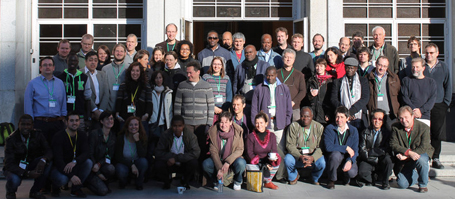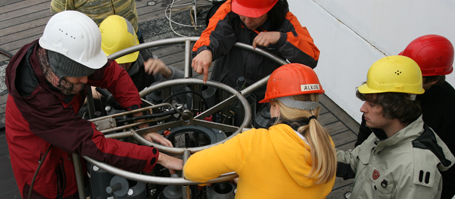Waves are an everyday sight for marine scientists and not always welcome. When research vessels rock too much, some complex measuring instruments (and the sensitive stomachs of some scientists) may suffer. Nevertheless there are waves whose discovery can amaze even the most experienced marine researchers. A team from GEOMAR Helmholtz Centre for Ocean Research Kiel, together with colleagues from Kiel University, experienced this wonderful surprize in January 2012 during an expedition on the research vessel METEOR for the Collaborative Research Centre 754 studying the oxygen minimum zones off Peru.
The waves in question are not the usual, familiar waves which are driven by winds on the water’s surface. Very similar wave motions exist within the ocean. These waves move along boundary layers where layers of water with differing densities meet. They receive their energy from wind changes and tidal currents. “Internal waves are responsible for mixing different water masses in the ocean. Thereby important nutrients are transported from the deep to the sunlit sea surface,” explains oceanographer Dr. Marcus Dengler from GEOMAR, one of the expedition participants.
When these waves reach the continental margins of the seas, special, non-linear internal waves result. They are characterized by very short periods of a few minutes and short horizontal wave lengths of only a few hundred meters. These non-linear, internal waves can cause particularly strong pulsating water movements that travel underwater towards the coast, in much the same way as surface waves do. At continental ridges they evoke an intense mixing process. Simultaneously they transport sediment up the continental ridge. The appearance of especially energetic, non-linear internal waves can be observed in different seas around the globe, for example at the continental margins off the West African coast, off the Straits of Gibraltar and in the Andaman Sea off the west coast of Thailand. Now, for the first time, they have been discovered off the Peruvian coast.
“During our expedition we noticed strong and fast changes of water mass characteristics,” reports Dr. Marcus Dengler. In addition the turbulence measurements conducted on board showed short-term, strongly increasing mixing occurrences close to the sea bed and in the upper layers of the water column. “Thus we can conclude that there, too, energetic, non-linear waves occur. The degradation rates of turbulent kinetic energy were the strongest ever recorded in the ocean,” continues Dengler.
Non-linear, internal waves at the continental margin were to be expected. “However we are surprised by their frequency and the intensity in the examined area,” says the expedition’s chief scientist Dr. Stefan Sommer from GEOMAR. Within 24 hours the scientists observed two to six wave trains close to the surface spreading towards the coast. The wave periods were very short – less than five minutes – while single wave trains lasted 20 to 40 minutes.
First analyses of the data by the researcher team on board the METEOR indicate an unknown relevance for the surfacing of cold water in coastal areas. “We assume that this is extremely important for the transportation of nutrients released at sea bed to the sea surface. At the surface they are responsible for an increased growth in phytoplankton, which, when it dies off, serves as a food source for bacteria. In doing so bacteria consume oxygen and thus contribute to the maintenance of the Peruvian oxygen minimum zone,” summarizes Dr. Sommer. Detailed results are now expected from the assessment of the samples obtained during the expedition.
Background Information: The Collaborative Research Centre 754
The distribution of oxygen in the ocean is controlled by a close concurrence of physical, biological and geochemical processes. In some core zones in the tropical oceans, the oxygen level is greatly reduced. Due to changes in environmental conditions, oxygen minimum zones are expanding. Through ocean circulation, this development can affect the global marine nutrient balance. The goal of the Collaborative Research Centre 754 “Climate-Biogeochemistry Interactions in the Tropical Ocean” is a better understanding of the interplay between climate variability, oxygen levels and biogeochemistry in tropical oceans. This understanding should enable more precise predictions of future changes in the ocean and resulting climatic consequences. Since 2008 the Collaborative Research Centre has been located at Kiel University and at the GEOMAR Helmholtz Centre for Ocean Research Kiel, and is financed by the German Research Foundation. It is currently in the second phase of funding which will last until 2015.
Contact:
Dr. Stefan Sommer (GEOMAR, FB2-Marine Geosystems),
ssommer@geomar.de
Dr. Marcus Dengler (GEOMAR, FB1-Physical Oceanography),
mdengler@geomar.de
Jan Steffen (GEOMAR, Communication & Media),
Phone.: (+49) 0431 600-2811,
jsteffen@geomar.de
…



